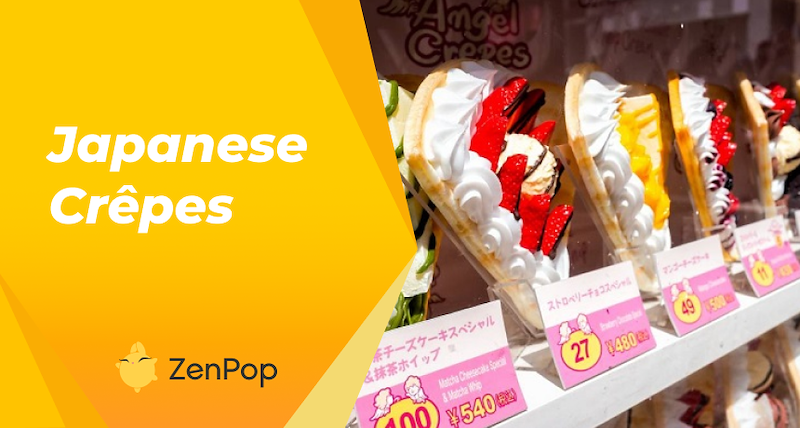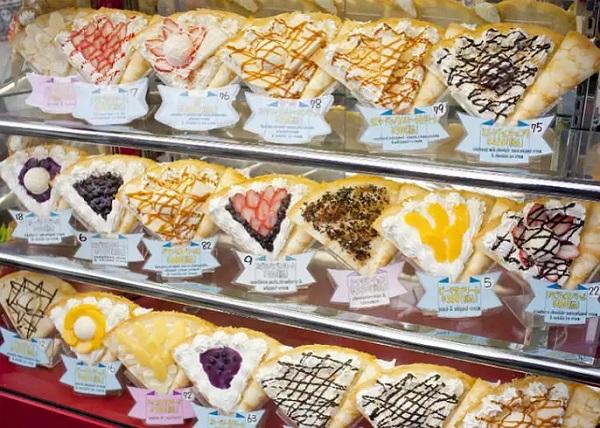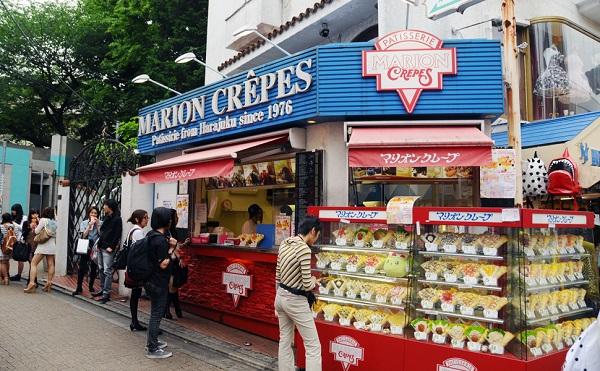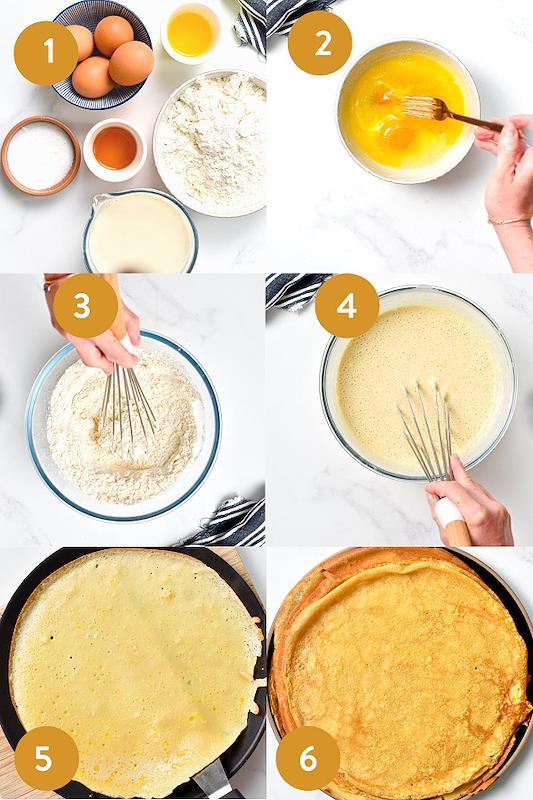
</title><meta name="robots" content="noindex"> The Ultimate Guide to Japanese Crêpes: A French Classic with a Twist
The crêpe is a traditional French dish that frequently uses the best ingredients. But if you head over to Tokyo's Harajuku district, you'll find a ton of people strolling around and savoring the dish's Japanese adaptation. Let's start our exploration of Japanese street food today with Japanese crêpes.
French Crêpes vs. Japanese Crêpes

Before we discuss them, there aren't actually too many differences between French and Japanese crêpes.
Back in the 13th century, a region of western France called Brittany is where the crêpe first appeared. Despite their widespread use, it's unclear how or when they even got onto Japanese streets.
Frequently, wheat flour, milk, and eggs are used to make French crêpes. However, buckwheat flour can also be used to make them, usually for savourier crêpes. Typically, this French dessert is prepared, stuffed with premium ingredients, and served. They are frequently rolled up or folded into burritos.
Crêpes first appeared in Harajuku as a street dish sometime in the 1970s. These street crêpes from Japan were thinner, wrapped in paper in the shape of a cone, and, most significantly, they contained a variety of unusual fillings. Japanese crêpes, unlike French crêpes, can have savory or sweet fillings and are made using wheat flour.
By employing a utensil to spread the crêpe batter around the pan or griddle, Japanese-style crêpes can be manufactured with an outer layer that is as thin as paper. Although this cuisine is sold on the street, good restaurants will cook it with lovely, crispy edges.
Dessert Crêpe Fillings

Japanese crêpes are designed to be a tasty treat that you may enjoy while shopping or when strolling down Takeshita Street, but French crêpes typically employ the finest ingredients. This indicates that while the components aren't particularly fancy, they are nevertheless tasty and manageable.
Fresh Fruits

You almost certainly won't find a crêpe vendor without even one fresh fruit option because fresh fruits are so widely available. Although typical commodities like bananas, strawberries, apples, and peaches are available, more seasonal and local fruits are also frequently offered. Consider eating kiwis, mangoes, Hokkaido melons, Japanese mikan (tangerines), and Amaou strawberries.
Some crêpes could include cinnamon apples for some extra sweetness and an apple pie-like flavor.
Sweet Dairy

In some form or another, dairy goods including ice cream, custard, and freshly whipped cream are also widely used. Because it has a softer sweetness, fresh whipped cream (nama kurimu) is a favorite in Japan. Custard, on the other hand, has a little more flavor and volume. A popular option is ice cream, which comes in a variety of flavors like vanilla, chocolate, and matcha (a Japanese powdered green tea).
Due to their widespread popularity, many dessert crêpes will have one or more of these toppings. Nevertheless, you can always request dairy without it by saying "nama kurimu nashi (without)" if it upsets your stomach.
Other Toppings

Additionally, delicious toppings you can use for your crêpe are almonds or a variety of sweet sauces. It's common to add strawberry, caramel, or chocolate sauce to crêpe fillings. Even Nutella is growing in ubiquity at crêperies.
Try a crêpe with kuromitsu (traditional Japanese syrup made from kokuto) if you want to give it a hint of Okinawa flavor (Okinawa black sugar). Azuki red bean paste can be used as a more conventional filler.
Delicious delicacies like cheesecake, chocolate cake, brownies, mochi, oreos, and more are available. Sometimes you'll find chunks of cake within your crêpe, while other times you'll find an entire slice.
Savory Crêpe Fillings
The same golden-brown thinness and flavor of a dessert crêpe are still used to make Japanese savory crêpes, also known as snack crêpes. Therefore, the filling is the only distinction between snack crêpes and dessert crêpes.
This portable snack can include a variety of proteins, including tuna, ham, bacon, hard-boiled eggs, and sausage. Lettuce, spinach, and green peppers are typical vegetable toppings. The sauces are actually what make it unique; just a few choices include salsa, pizza sauce, and Japanese mayo.
Popular Japanese Crêpe Stands

There are many locations to eat crêpes in Tokyo. However, Harajuku is the ideal spot to go if you're seeking for options. There are a ton of options, but these are just a few of the most well-liked.
One of Harajuku's two oldest crêperies, Marion Crêpes opened in the 1970s immediately following the now-closed Angel Hearts. Its blue, red, and white color scheme contrasts with the pink of other establishments on Takeshita Street but is less ostentatious.
With a storefront in bright white and pink, Santa Monica Crepes blends in a little better with the overall Harajuku cutesy vibe. You can't miss it because it even has a sign with a strawberry crêpe on it that lights up at night.
Despite being located outside of Laforet Harajuku on the first level, Cafe Crepe Laforet is accessible from Takeshita Street. This well-known shopping center is home to many excellent shops, delectable eateries, and even a Sailor Moon store. You can thus go outside and purchase a crepe to unwind after a day of shopping!
How to Make Japanese Crêpes at Home
Everyone loves street food, especially when it comes to Japanese desserts like these thin crêpes.
So let me share our secrets to making them perfect every time.
Ingredients
To make these delicious Japanese style crepes, you need:
- All-Purpose Flour or cake flour, or any white flour you have at home, including gluten-free all-purpose flour.
- Eggs – Prefer free-range eggs for a better taste.
- Egg Whites – Keep the yolks for another recipe.
- Milk – or any other plant-based milk alternative.
- Sugar – use sugar-free crystal sweeteners for a sugar-free version.
- Vanilla Extract
- Melted Butter
Preparation
- Sift the flour, sugar, and salt together in a big bowl. Mixture should be combined by whisking it with a hand whisk.
- In another bowl, whisk the egg whites and eggs. Place aside.
- The beaten eggs, half the milk, vanilla essence, and melted butter should be added to the dry ingredients by creating a well in the center.
- The remaining milk should be added gradually while you whisk. The batter need to be thin and silky. It's okay if some little bumps develop.
Cooking the crêpes

- Over medium heat, preheat a crêpe pan or pancake griddle. Butter or oil can be applied to the surface by rubbing it with a piece of absorbent paper.
- Scoop out the crêpe batter and place it in the center of the heating pan.
- To spread the batter uniformly across the surface, tilt and rotate the pan.
- The edges begin to crisp up and get golden brown after one minute. Using a flat spatula, gently slide beneath the crêpe after lifting the edges.
- Flip the crêpe over quickly, then cook the other side for an additional minute.
- The crêpe ought to have tiny, rounded brown dots.
- The crêpe should be taken from the stove and allowed to cool on a dish. The crêpes cool as they rest on the dish at room temperature.
- While you prepare the remaining Japanese crêpes, cover the platter with foil to keep them warm.
And that's it, enjoy your homemade Japanese crêpes and impress your friends on their next visit!
In the meantime, if you want to prepare some additional Japanese snacks for them to enjoy, why not get a Japanese Snack Box delivered to your home?


